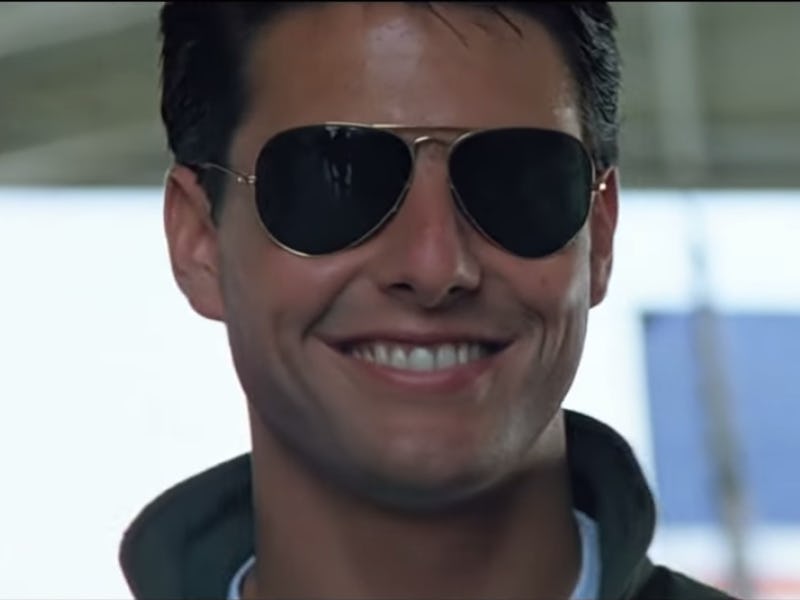The Original 'Top Gun' Totally Dodged the Cold War
They've got the need, the need for non-political speed.

In May of 1986, way before he headlined (and stunted in) gigantic franchise sequels like the upcoming Mission: Impossible - Rogue Nation (in theaters on Friday), Tom Cruise was just a budding star coming off of two moderate box office hits with All the Right Moves and Risky Business. But it was his turn as pain-in-the-ass ace flyboy Maverick in the action romance classic Top Gun that catapulted him into mega-stardom.
A sequel has been in the works for years, with Cruise himself recently saying he’d “like to get back into those jets,” and movie producer David Ellison confirming that Top Gun 2’s plotline would be set around the armed forces “world we live in today” with an emphasis on “drone technology.” If it’s anything like the first movie it will ground its action squarely within a pro-militaristic American viewpoint, and then speed away from making any legitimate point about it faster than Maverick can fly in an inverted negative 4G dive. The original Top Gun took its Cold War context and then squandered it at basically every turn.
There has potentially never been a more popular jingoistic movie that lacked a specific reason to be that way other than Top Gun. Its tale of no-nonsense fighter pilots at the pinnacle of their flying abilities is unabashedly slick, but it gives its characters no outlet to show for their allegedly valiant service other than vaguely defined armed conflicts against faceless — and, for the most part, nameless — enemies shooting around at supersonic speeds in jets. To viewers of Top Gun, all you need to know is that Maverick is good because he says he is, and the people he’s flying against are bad because their planes are painted black. It doesn’t get much more complicated than that.
By refraining from mentioning the actual tensions between the U.S. and the Soviet Union at the time, or any iota of the Cold War as a whole, the movie undercuts its own message about putting all your personal hangups and bullshit aside to be on duty when your country needs you. It’s then nothing more than a flashy repository for florid love scenes, a very sweaty and muscly volleyball game, and a few [constant](https://youtu.be/siwpn14IE7E repeated Kenny Loggins songs (though, to be fair, those are catchy as hell).
This isn’t to say that the movie needs to be outright American military propaganda, though the details of the plot definitely want to be. Take for instance the movie’s opening sequence, in which Maverick and his radar intercept officer Goose (played by Anthony Edwards) engage with hostile aircraft in a deadly cat-and-mouse dogfight in restricted airspace over the Indian Ocean, which ends with the hostiles being chased off without either side firing a single bullet or missile.
The scene works as a Cold War metaphor — it’s the ultimate socio-political pissing contest in which no one manages to let it flow. Yet the only details we have to go on about who exactly those hostiles are remains unsaid. We get conveniently placed red stars plastered on the enemy planes and each helmeted pilot’s flight mask, and then there’s the fact that Maverick and Goose spend the entire fracas shouting about MiGs here and MiGs there.
“MiG” is a prefix that references the former Soviet military design company, the Mikoyan-and-Gurevich Design Bureau, which provided aircraft to the Soviet air forces, and partly still does. Yet the jet that Maverick and his pals dogfight against — what the characters call a MiG-28 — is a fake. Mikoyan-and-Gurevich never produced a MiG-28, and the jets that appear in the movie are actually American-made Northrop F-5F Tiger II fighters, the equivalent of bit players from the Midwest mumbling their lines in a vaguely Russianish accent.
This gets even murkier in the so-called “crisis situation” at the end of the movie, which sees the Top Gun cadets actually turn the Cold War into a hot one, with an armed conflict against MiG fighters less than 24 hours after they graduate. “Tension are high,” their commanding officer tells them, but tensions with whom? Undeterred by a lack of specificity, our intrepid pilots save the day again by offing three enemies before scaring away the rest. There’s a celebration, Maverick gets the girl, and the movie ends. In related news, the Berlin Wall fell a mere three years after Top Gun opened.
Top Gun isn’t specifically a war movie, so in a way it doesn’t really need to name its enemy, but it’s so indebted to borderline pornographic (and fascist) images of militarism that its vapid political non-committal is astonishing. Red Dawn and Rambo: First Blood Part II went totally balls-to-the-wall. Top Gun took the ahistorical soap opera approach.
Actor Tom Skerritt’s hardass teacher character spouts off lines like, “Although we’re not at war, we must act as if we are,” and if they’re at a school to train the best pilots in the U.S.A. but never mention why — and one of them even dies in the process — then what’s all the fuss about? Highway to the danger zone, pshaw.